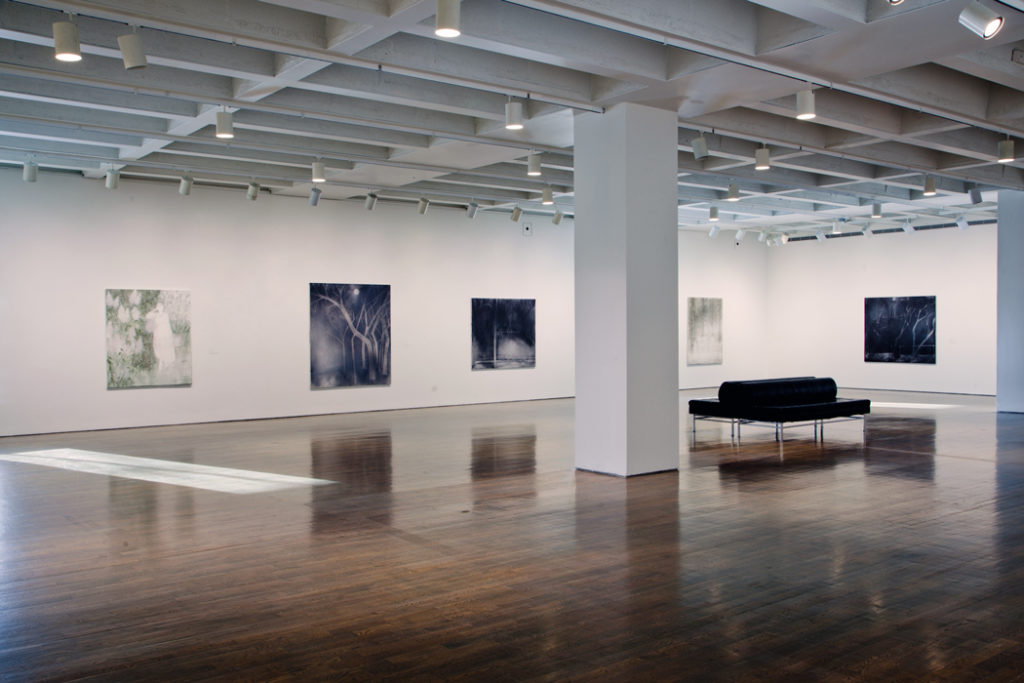Painting is the draw at the Art Gallery of Ontario for the next few months with the overlap of two remarkable but very different exhibitions. “Jean-Michel Basquiat: Now’s the Time” is a powerhouse survey of works by the 1980s New York–art star. “Land lies in water” is a quiet assembly of recent paintings by the German-born, LA-based artist Silke Otto-Knapp.
The Basquiat show presents a deep excursion into the cultural and racial politics that drove Basquiat’s life and art. The paintings are astoundingly prescient engagements with money, power and alienation. Their rough and fragile fragmentation comes across as a literal analogue of Basquiat’s heroic broadcasting of creative Black identity. It is a show in which we see a young man acutely alone as he discovers his own self-worth, a young man with an encyclopedic mind tracing the outlines of a disvalued history. Picture after picture, if not self-portraits, are then at least kin-portraits of an underclass whose time had come to redress the balance and write its own history. The pictures are often informational, inscribed and scribbled with lettered texts. When they aren’t, they are an assortment of frenetic foregrounds all staking ownership and occupation of their own space. Basquiat’s art delivers an assertive but fraught poetry of personal arrival made poignant by his early death at 27 in 1988. If now is the time as the title declaims, it is because the human story in Basquiat’s art won’t go away anytime soon. The volatile mix of race and poverty and prejudice shapes headlines today.
Otto-Knapp’s exhibition, located in several downstairs galleries including the Thomson Collection of Ship Models, activates an altogether different kind of engagement. Where the Basquiat paintings bask in colour and friction and heroic scale, hers are monochrome, close-valued and intimate. As viewing objects they deal in subtlety and slow time as they build soft grey scrims that hold various images of dancers, stage sets, home interiors and working women artists (Florine Stettheimer, Emily Carr and Anna Halprin among them) together with more recent nocturnal and coastal landscapes.
The 30 paintings in the show are uniformly meditational as they create a gauze-like picture space that relies on the shallow, often transparent overlapping of chalky water-based paint. Each surface registers as a construction of memory. They are paintings distinctly apart from now; paintings aimed at tradition and retrieved creative space. With their moonlights, forests and curtained gateways, Otto-Knapp’s pictures honour mysteries of vision. Even her open daylight landscapes carry a richly layered quietude. They are the kinds of pictures around which words like tenebrous, crepuscular and nebulous hover like angels of wonder and inarticulate speech.
Several pictures are standouts. Three marine paintings are hung on one wall in the room housing the Thomson Collection of Ship Models. Two on either end show close-cropped sail boats that accentuate the gliding grace of Otto-Knapp’s style and her playful interaction with the boat models in the gallery. A larger, square painting in the middle (Seascape, 2012) brings a more experiential engagement as a scumble of white shapes leads to clearly defined sails riding the high horizon of the picture. The work offers a time-lapsed view of both travel and wavering concentration that speaks in part not only to its own picture space, but also to the surrounding model collection.
Upstairs in the Lind Gallery are several paintings related to a recent Fogo Island residency that show the bare, rocky coast from various views, including a slightly elevated aerial view that monumentalizes the landscape and makes manifest the exhibition title “Land lies in water.” If Otto-Knapp proceeds with minimal working means, the results are always otherwise. Her paintings can have the look of burnished pencil or silverpoint, and in the Fogo paintings there is delight in noting how she has rendered the sky and the rocky islands with warm greys and the water with a cool range. Whether in the communicative contrast of warm against cool here, or in the far-off patches of white snow that appear between the cascading black trunks of Winter Trees (2012), there is intricacy in her simplicity. Her paintings specialize in long continuities of tradition that are reinvented to affirm the complexity of place and perception. To extend the implications of her title, they are the land in the water of art.
Both artists, in their own ways, do painting proud.









